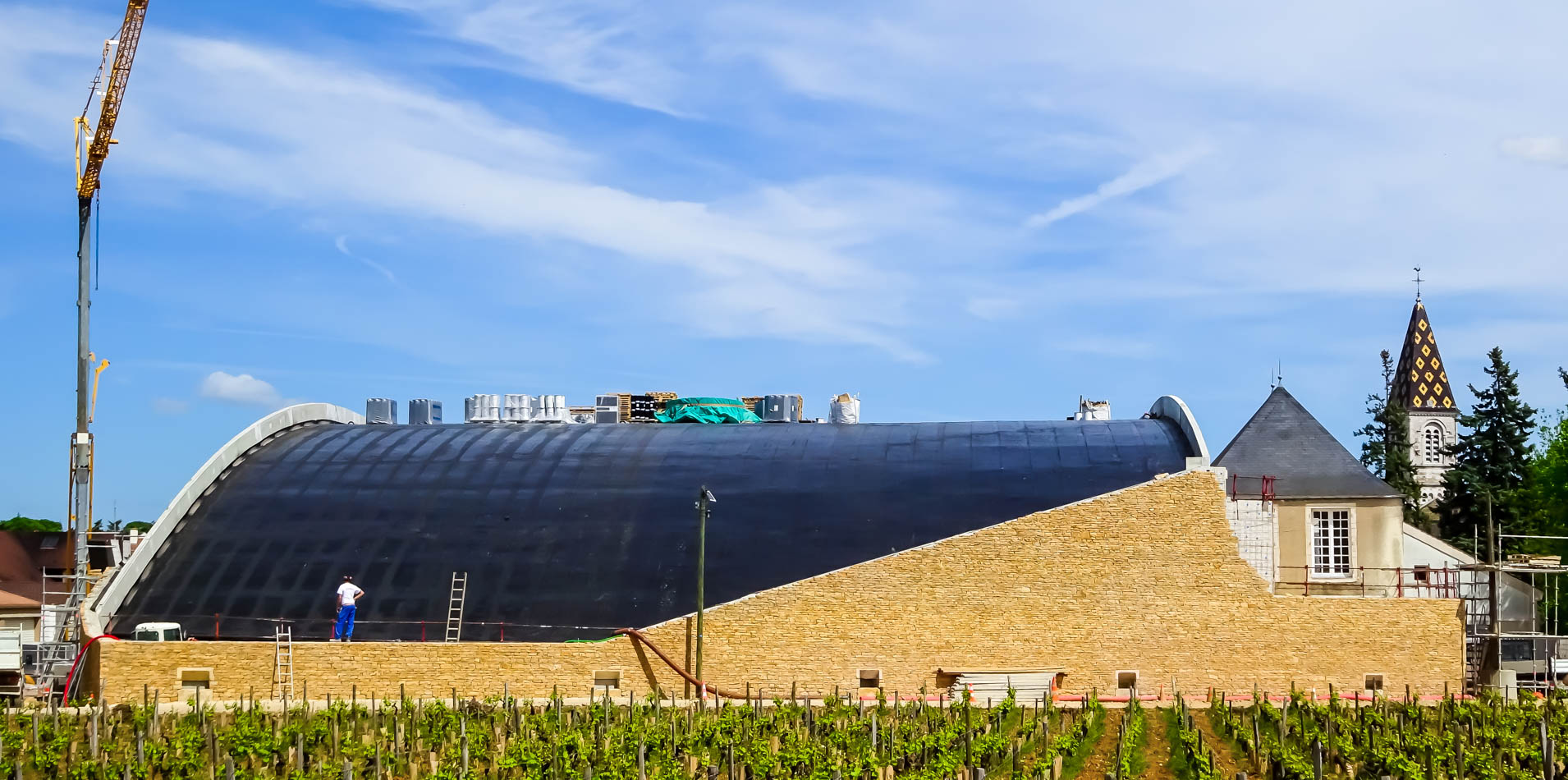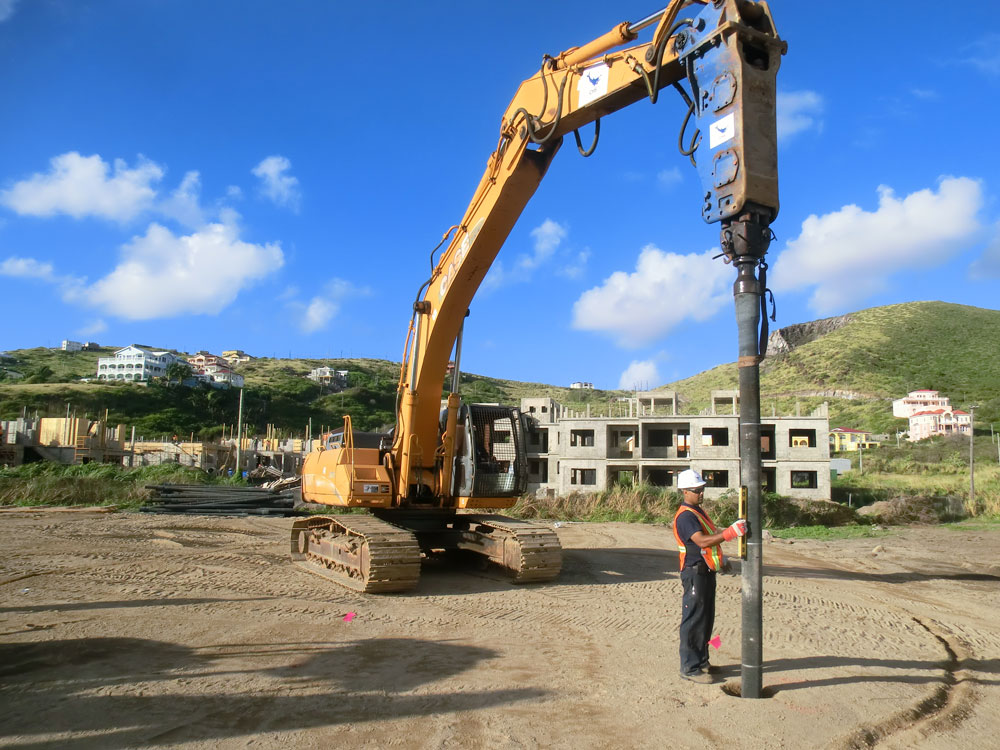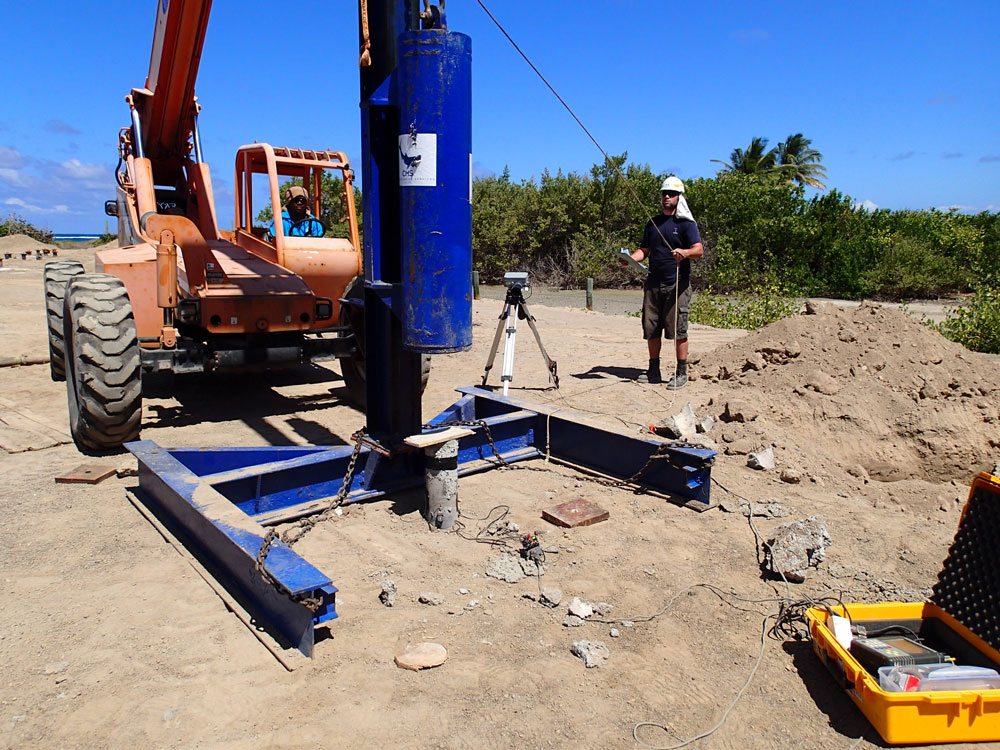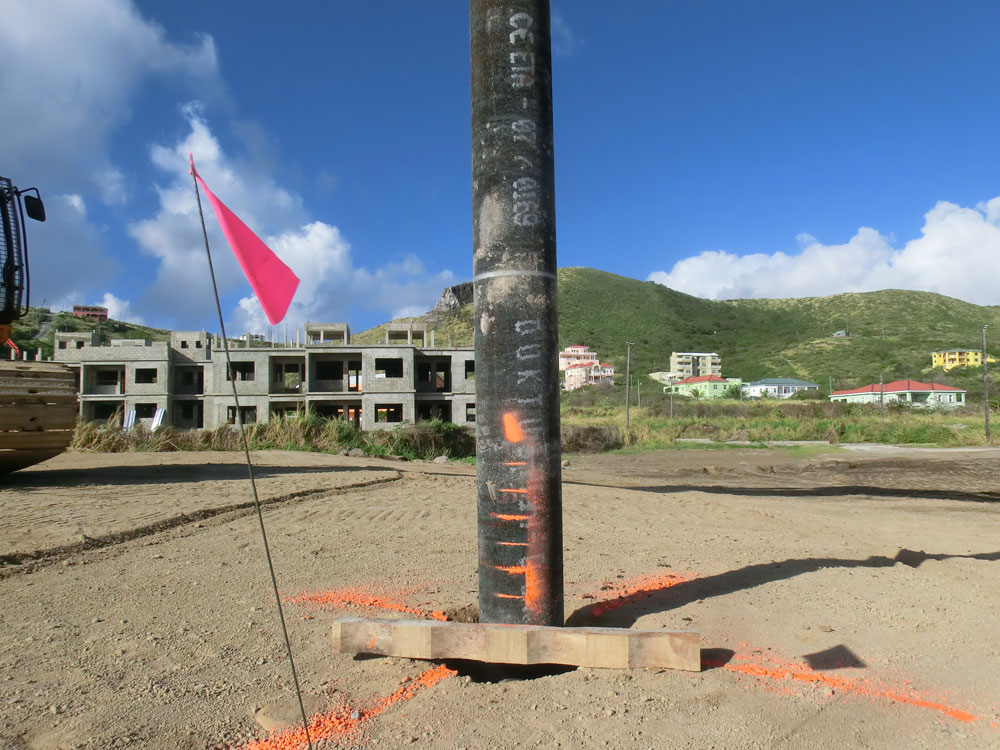Case studies
-
Rana Motors and Metal Works Engineering Co. Ltd. choose driven ductile cast iron piles
During February and March 2015, Coulon Pieux Battus and Talamas Frères completed the installation of 480 driven and grouted piles in the city of Accra (Ghana). The piles will serve as deep foundations for Rana Motors' new headquarters. An economic and practical choice that will enable the Ghanaian company to shorten the construction time and simplify the organisation of the project.
New facilities in a safe location
The project involves moving the facilities of Rana Motors, which are currently located in an urban zone with a high risk of flooding. The latest torrential floods on the 4th of June 2015 resulted in more than a hundred victims in the Accra neighbourhood, and caused damages in excess of 10 million euros to car fleets.
The strong rain seasons cause regular flooding in the capital city. The southern industrial zone of the city, where the automotive industry has been developing, is the most severely touched, forcing Rana Motors to move its headquarters. The new plot of land, located upstream and on higher grounds is less vulnerable to flooding.
The new buildings are designed as three blocks of up to four storeys high (blocks A+B for offices, showroom and an open-air car park, covering an area of 1,800 m², and a separate block C of 1,100 m² used for a showroom and workshops). The region of Accra is in an area of low seismic activity (Accra earthquake of 1974) and para-seismic rules of design therefore apply.
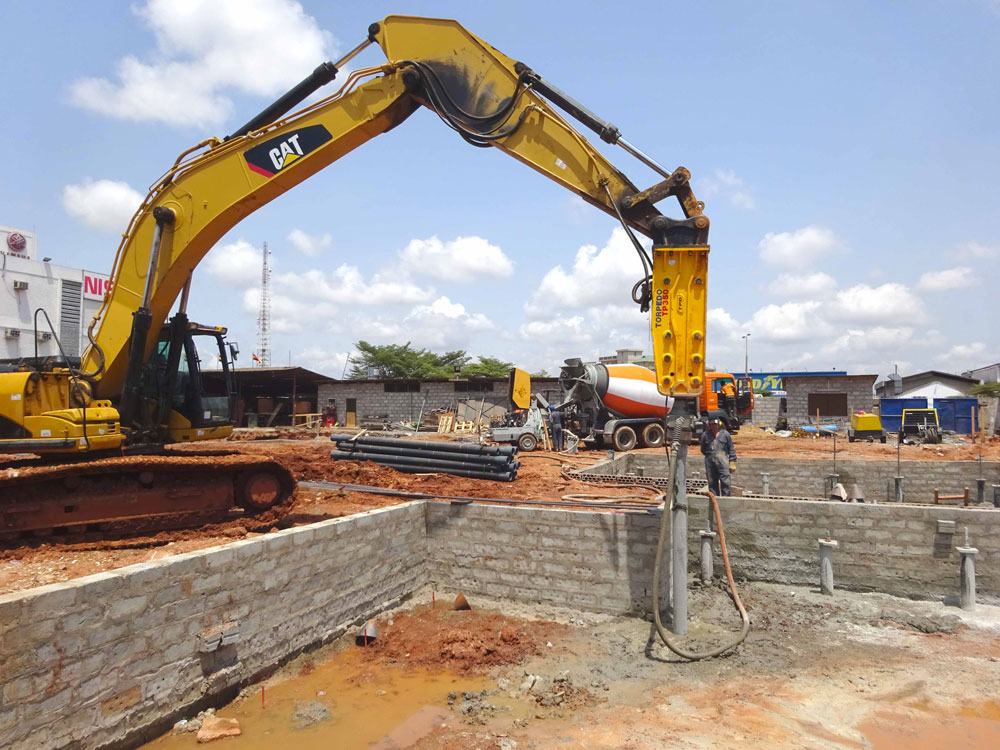 Piles driven into the foundation pre-excavations with simultaneous concrete injection (Caterpillar 330DL, Torpedo TP350, Putzmeister P715).
Piles driven into the foundation pre-excavations with simultaneous concrete injection (Caterpillar 330DL, Torpedo TP350, Putzmeister P715). Cast iron tubes 170/09.0 mm, conical overhanging shoes Ø320 mm, load bearing plates 250x250x35 mm, traction bars Ø40 mm.
Cast iron tubes 170/09.0 mm, conical overhanging shoes Ø320 mm, load bearing plates 250x250x35 mm, traction bars Ø40 mm.In the heart of the coastal region of accra
A large part of the sedimentary basin of Accra stands upon successive layers of gneiss and schist (Dahomeyan Formation). The presence of sandstone and schist (Accraian Series), and of quartzite and phyllite (Togo Series) has been observed in the city of Accra. In the upper section, alluvium, along with marine and wind-carried sediments cover an area of rock alteration (sandy, gravelly clay)
At the project's location, the relatively consistent geological nature of the terrain shows a recent layer of excavated material (1.5 m NSPT=5), a layer of silt-sandy clay and loose sandy-clay gravel of sedimentary origins (3.5 m NSPT=2) becoming more compact and hard and similar to decomposed rock (3.0 m NSPT=38), giving way to a schist substratum with a relatively altered surface (4.0 m NSPT=42) turning into unaltered schist to a depth of 12.0 m (NSPT>50).
The level of ground water has been measured at 1.2 to 1.8 m in depth, in relation to the current level (refilled) of the land. The groundwater is severely aggressive (high concentration of sulphate and chloride). Accra's coastal plain salinization is explained by the interaction of three phenomena: the dissolution of rock salt, the intrusion of seawater and the evaporation of surface water.
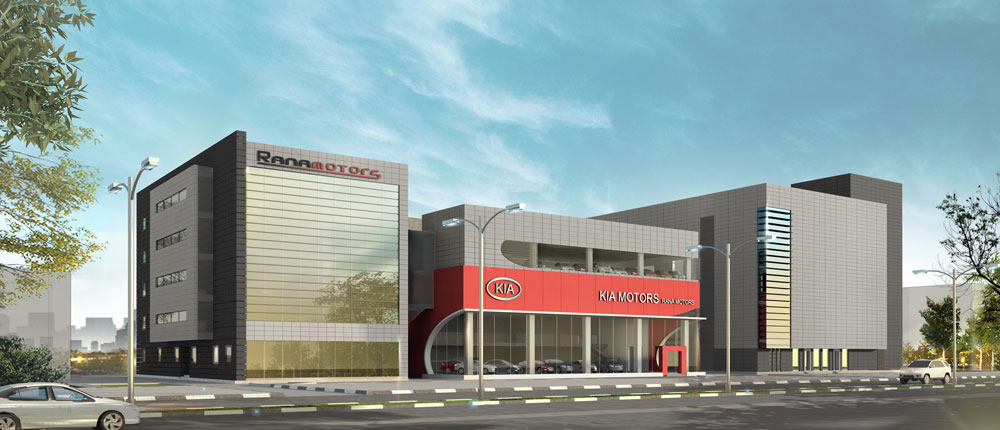 Design by the architectural practice Lajjimark Design Sal. From l. to r. block A (offices), block B (showroom, open air car park) and block C (showroom and workshops).
Design by the architectural practice Lajjimark Design Sal. From l. to r. block A (offices), block B (showroom, open air car park) and block C (showroom and workshops). Dynamic load test with the SIMBAT method: measurement of displacements at the pile head by optical theodolite, falling mass of 2.0 t.
Dynamic load test with the SIMBAT method: measurement of displacements at the pile head by optical theodolite, falling mass of 2.0 t.Sizing according to european standards
The project was initially designed to use bored and tubular piles of 60 cm and 80 cm diameter (313 piles, average length 18.5 m). The new sizing (alternative version) includes a total of 480 driven ductile cast iron piles, with a diameter of 32 cm and a length of 12,5 m. The calculations by the engineering office Terrasol are based on European standards and on the national applications standard of Eurocode 7 (NF P 94-262).
BE-type piles (rated 4, category 10) with soil displacement are reinforced on the entire length by a tube of ductile cast iron 170/09.0 mm. The construction requirements (overhanging shoe of Ø320 mm and simultaneous injection) guarantees a minimal grouting of 7.5 cm and provides good protection against corrosion.
Horizontal forces (seismic) are partly carried by the piles, and partly by the soil surrounding the underground foundation pile caps. Piles that undergo traction forces (262 in total, 600 kN ELU) due to seismic movements are fitted with an additional reinforcement bar of Ø40 mm.
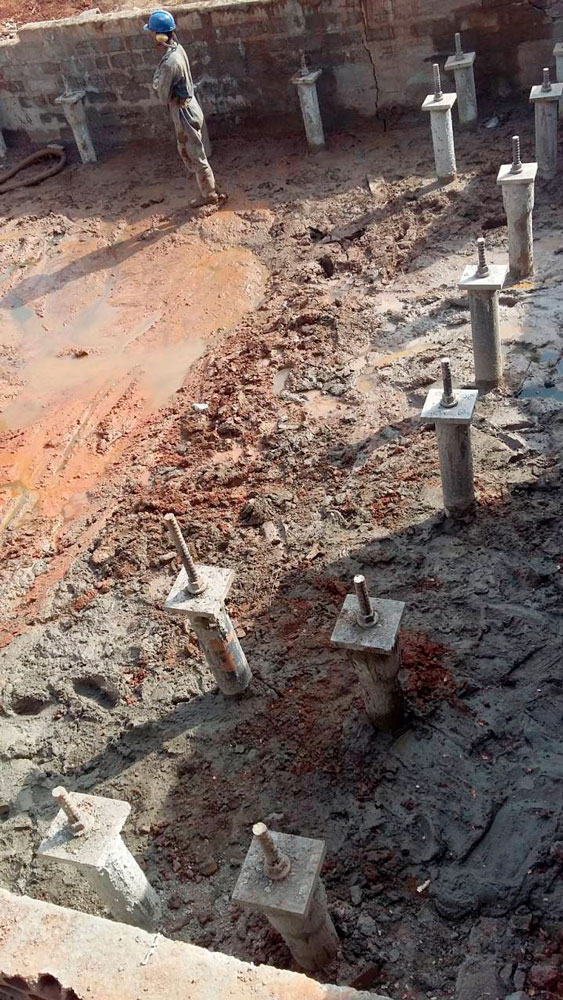 The piles are cut off at project dimension before being fitted with a load bearing plate and an additional reinforcement bar on its entire height.
The piles are cut off at project dimension before being fitted with a load bearing plate and an additional reinforcement bar on its entire height.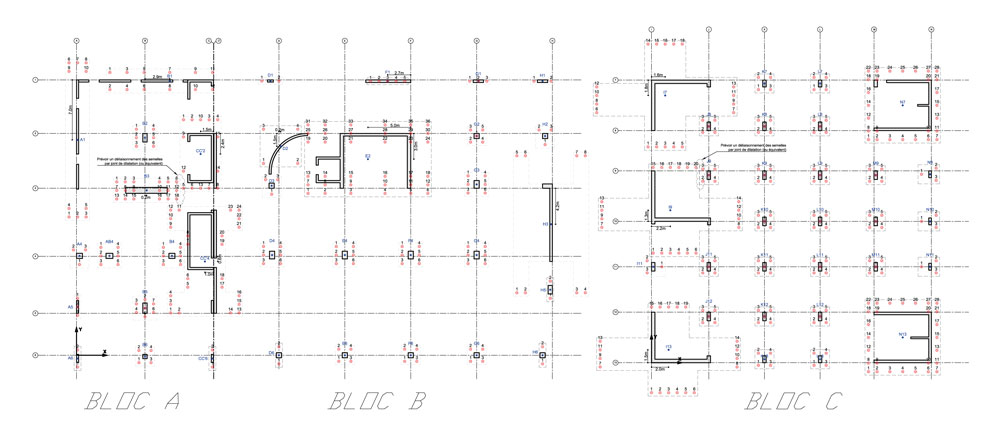 Distribution of 480 piles under column-type (compression loads) and wall-type (tensile and compression loads) foundation caps.
Distribution of 480 piles under column-type (compression loads) and wall-type (tensile and compression loads) foundation caps.Very tight work phasing
The completion date of the foundation works before the next rainy season (from May to July) and the late start of preparatory work in February (demolition, terracing, and formwork of the foundation caps) impose a contractual deadline for the completion of the piles reduced to 40 days.
The pile project is given to the company Talamas Frères and is under the local supervision of the company's director, Mr Jacques Talamas. The single workshop of 4 people has a daily turnover of 150 meters, including the trimming and the preparation of pile heads, and the installation of traction bars inside the tube filled with concrete.
A Torpedo TP350 (5.880 Joule/stroke, 350-650 strokes/minute) hydraulic hammer mounted on a Caterpillar 330DL digger enables to drive the piles, while a Putzmeister P715 (70 bar, 20 m³/h) piston pump feeds the concrete required for simultaneous injection.
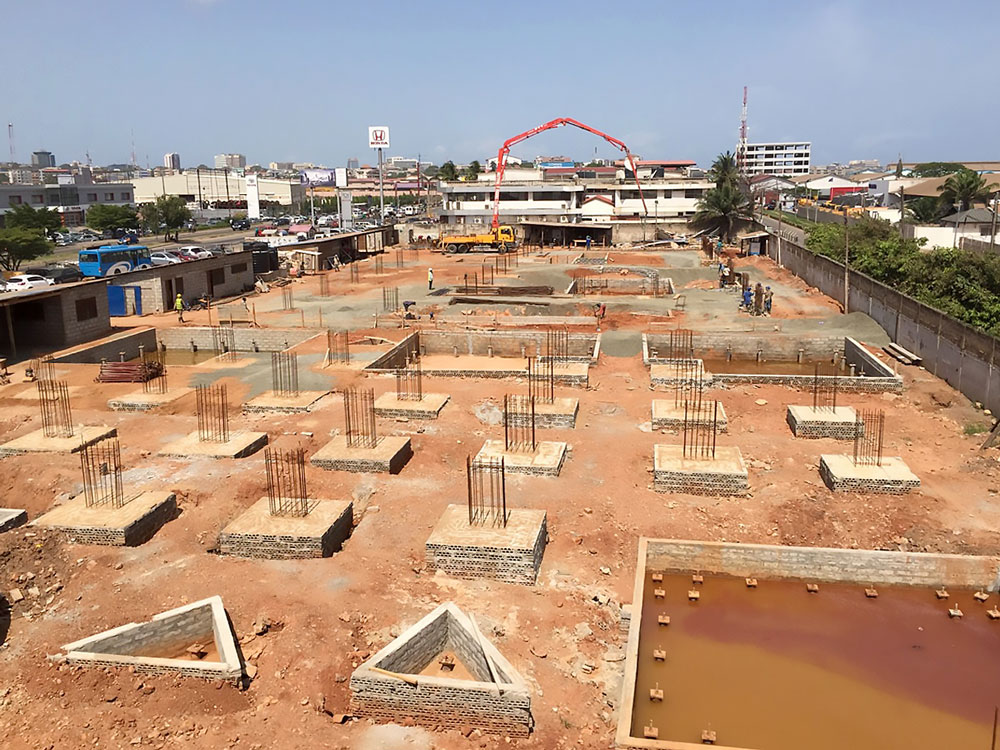 The foundation caps are chained to one another to guarantee a consistent distribution of horizontal forces (seismic) on all piles.
The foundation caps are chained to one another to guarantee a consistent distribution of horizontal forces (seismic) on all piles.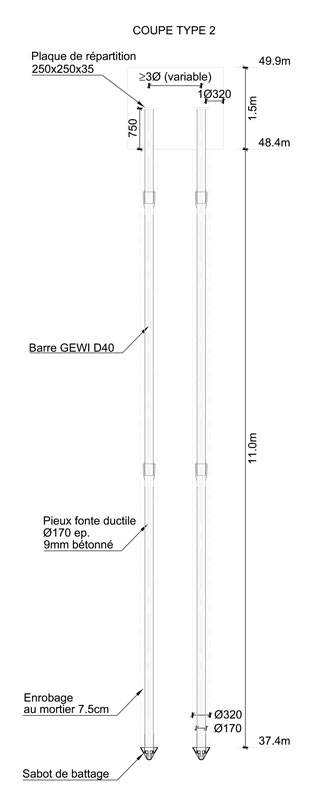 Outline schematic of a driven and grouted pile Ø320 mm, length 12.5 m reinforced with a cast iron tube 170/09.0 mm and a traction bar Ø40 mm.
Outline schematic of a driven and grouted pile Ø320 mm, length 12.5 m reinforced with a cast iron tube 170/09.0 mm and a traction bar Ø40 mm.Dynamic load tests
The bearing capacity of the piles has been confirmed with four dynamic load tests using the SIMBAT method. The dynamic impacts are generated by a falling mass of 2.0 tons. The fall heights are increased by increments of 0.2 m.
The signals of force, acceleration and displacement (optical theodolite) are recorded and processed to create an equivalent static load-insertion curve, by adding the permanent insertion of the pile under each impact and the elastic compression value.
The total displacement measured at the maximum required testing load (1.750 kN, safety factor 2.0) is of 13 mm (permanent insertion 1.5 mm + elastic compression 11.5 mm). The tests carried out by Testconsult Ltd. were extended to loads of up to 2,500 kN (height of fall 1.2 m), causing a cumulated maximum insertion of the pile of 3.63 mm and an average elastic compression value of approximately 15 mm.
Jérôme Coulon,
Gérant Sarl COULON PIEUX BATTUSWhy choose driven ductile cast iron piles?
The company Rana Motors supervises all of its construction projects, from the design to the completion. Financial requirements and time constraints have an influence on our technical decisions. The driven pile solution was the most efficient, as it is the most economic and the fastest solution to implement. The deep foundations were completed in just 40 days. The absence of waste materials associated with traditional drilling and cutting-off, along with the possibility of driving the piles directly into the foundation pre-excavation, have greatly accelerated the time it takes for the project to reach surface. Material compactness and a reduced storage area help optimise space management on the work site, which has enabled us to work in parallel with the demolition, terracing, and foundation teams. Finally, the confirmation of the bearing capacities through drive tests and the certainty of the pile's resistance thanks to the tubular reinforcement guarantee a homogeneous quality of execution.
MR. Malek El Assaad
Head of projects at Rana Motors. -
Koi Resort & Residences, Half Moon Bay, St. Kitts: a solution of driven ductile cast iron piles to overcome the problem of liquefiable soils
Pre-fabricated driven ductile cast iron piles are anchored in the lime substratum at a depth of 20.0 m, below the level of potentially liquefiable sand. They offer a cheap solution to reduce terracing work due to static and seismic effects. The first phase required 330 driven piles, and was completed in one month by CMS Ltd.
The $200 million Koi Resort & residences project is part of the economic development plan launched by the government of Saint Kitts and Nevis. Approved for the purpose of the citizenship through investment programme, the project involves a luxury resort made of 5 to 6-storey buildings (apartments and suites) and villas with 1 or 2 storeys. Built on former marshland in a seismic area, the multi-storey buildings rest on deep foundations, whereas the villas are superficially founded on compacted excavation material.
Former maritime marshland
The State of Saint Kitts and Nevis in the Caribbean belongs to the Leeward Islands (Society Islands). The project covers a surface of 6 hectares and is located on the east coast of Saint Christopher Island (Half Moon Bay). To the east it is limited by the Atlantic (beach coast, sand dune: altitude +1.5 à +3.0 m) and to the west by a hill that culminates at 140 m approximately (Conaree Hill, land area: altitude +5.0 m). To the north, the site is limited by surviving marshland and to the south by the Royal Saint Kitts Golf Club course.
When geotechnical surveys were conducted, the former marshland covered most of the site with a depth of approximately -1.0 m and a water level of + 1.0 m. A total of 28 survey pits were dug to depths of 7.5-20.0 m, with standard penetration tests SPT with 1.5 m passes carried out in the marshland and the dry part of the site.
The soils are homogeneous: a loose to very loose layer of silt and clay and sandy clay (NSPT=6) reaching a depth of 4.5 m covers a thick layer of loosely packed sand (NSPT=18). Three of the survey pits reached the lime substratum at a depth of about 18.0-20.0 m. The survey pits also revealed a layer of hardened sand (NSPT>50) of variable depth, as well as pockets of loose to very loose sands with silt and clay, locally rich in organic material (NSPT<10).
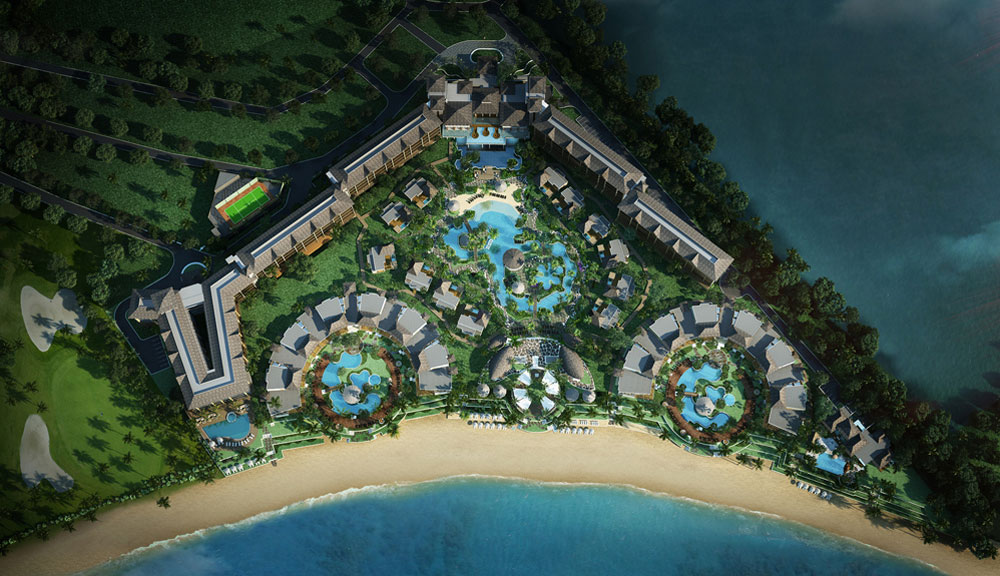 The 5 to 6-storey buildings create an L-shaped structure, the 1 to 2 storey villas are built around the swimming pools.
The 5 to 6-storey buildings create an L-shaped structure, the 1 to 2 storey villas are built around the swimming pools.Site preparation
Following the drying of the marshland and soil replacement on a depth of 1.5 m (loose and compressible clay), the terracing work - mainly fill materials, and locally excavated materials on dry land - enabled to level the site at a ground level of 1.5 m to +3.0 m.
The soil replacement includes removal of silt-clay soils and their replacement with a layer of compacted filling material. Its purpose is to prepare a stable driving platform for the 5 to 6-storey buildings (deep foundations) and to guarantee sufficient load bearing properties of the soil for the villas with 1 or 2 storeys (superficial foundations).
Potentially liquefiable sand
The soil liquefaction potential analysis (S&ME, Inc.) concludes that the sand presents a moderate to severe risk at 3.0 to 12.0 m in depth: LPI=7 (liquefaction potential index) for PGA=0.2 g respectively LPI=29 for PGA=0.4g (peak ground acceleration). The report recommends that the 5 to 6-storey buildings should have deep foundations by driven piles anchored in the healthy layer that lies underneath the sand that faces seismic liquefaction risks.
The original solution includes prefabricated concrete driven piles of 300x300 mm and 350x350 mm for axial compression loads of 35 T and 45 T respectively. The piles anchored in the lime substratum at a depth of about 18.0-20.0 m must limit packing effects due to static and seismic loads at an acceptable level for the structures, and at all calculation thresholds.
The installation of the concrete piles might require preliminary drilling operations through hardened sand levels to ensure an implementation at 20.0 m in depth, without the danger of excess loads during driving operations (cracks, breakage, and obstacles). The layers of hardened sand can be encountered with a thickness greater than 1.5 m and at various site depths.
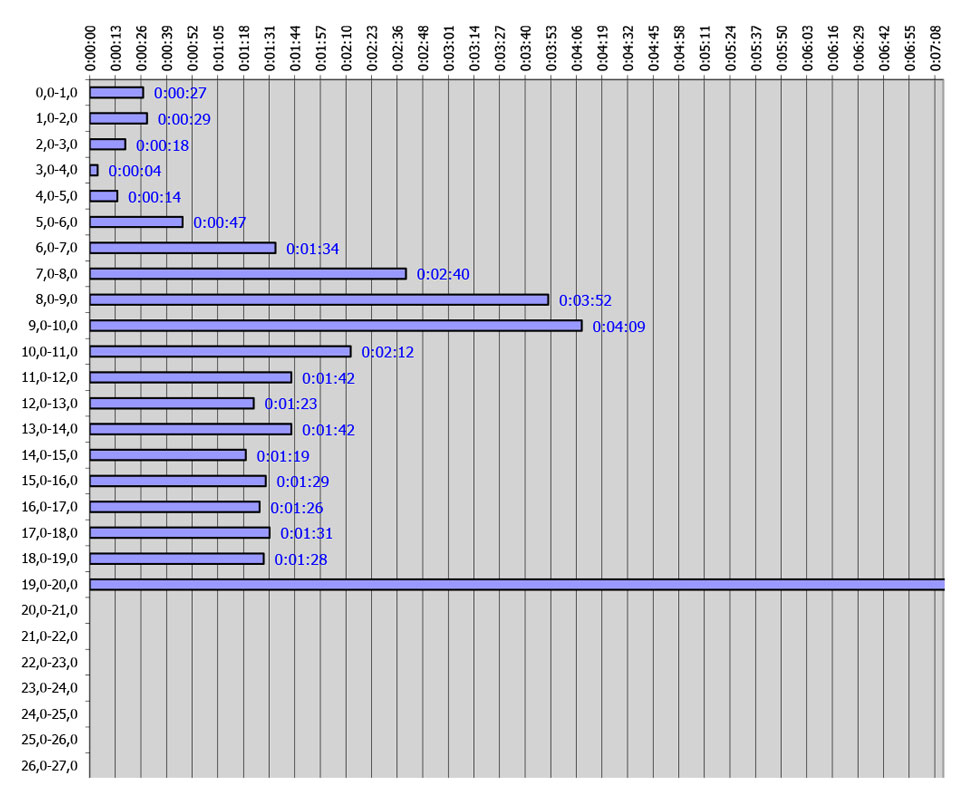 Pile #01 drive measurement: clay and sand with clay 0.0-5.0 m, relatively loosely packed sand 5.0-19.0 m with hardened layer 08.0-10.0 m, lime substratum at 20.0m
Pile #01 drive measurement: clay and sand with clay 0.0-5.0 m, relatively loosely packed sand 5.0-19.0 m with hardened layer 08.0-10.0 m, lime substratum at 20.0mCast iron piles in limestone
Due to difficulties of rapidly manufacturing and supplying pre-fabricated concrete piles on the island and driving them, without damage, to the required depth, the contractor naturally had to envisage an alternative solution. CMS Ltd. is the one to provide the solution and completes, in 32 working days, 330 driven ductile cast iron piles, with an average length of 19.30 m.
The piles are made of 170/09.0 mm tubes of ductile cast iron with a rated length of 5.0 m, delivered by sea in 20-foot long closed containers. They are fitted, at the base, with a three-bladed driving shoe and a platinum load bearing head of 250x250x35 mm. The piles are driven until they meet the lime substratum and filled with concrete.
The tubes slot into one another (tapered coupling Plug&Drive©) to create the rigid reinforcement of the pile. The length of the pile is therefore adapted to the depth of the rocky substratum and varies, for the entire project, between 17.5 m and 31.3 m. The control of the end-of-driving criterion (residual insertion during one minute of successive blows) guarantees a coherent 700 kN working load for all the piles. Horizontal forces are carried by a system of stringers buried in the excavated compacted material and chained to one another in both Y and Y directions (design by Amarna Consult Ltd.).
The hydraulic 40T Case CX330 crawler digger is provided locally, whereas the hydraulic hammer NPK H16X of 2.5T (6.780 joules/stroke, 380-480 strokes/minute) is shipped by boat.
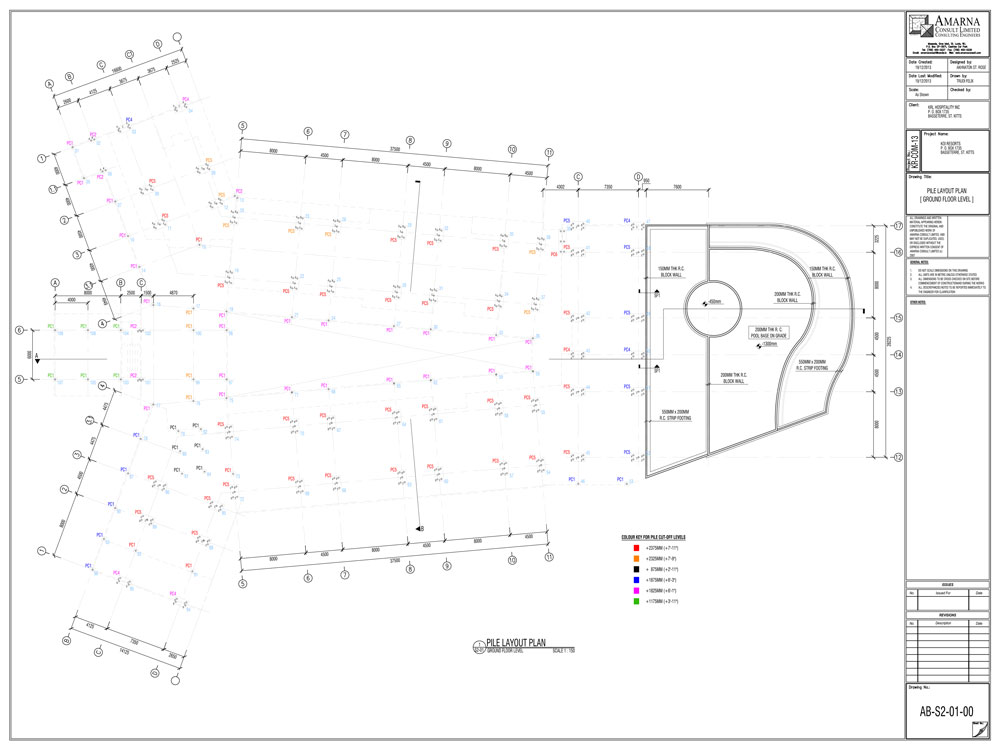 Foundation plan for blocks A and B (phase 1). The 330 piles are grouped in sets of 1 to 6 piles, interconnected by stringers (Amarna Consult Ltd.).
Foundation plan for blocks A and B (phase 1). The 330 piles are grouped in sets of 1 to 6 piles, interconnected by stringers (Amarna Consult Ltd.).Simbat dynamic testing
In total, 25 dynamic load tests were carried out using the Simbat method on the projects piles. The tested piles underwent a maximum dynamic load of 1.480-2.100 kN (2 to 3 times the working load QELS=700 kN).
The average packing distance measured at the pile head under twice the working load is of 15.4 mm (permanent insertion 0.6 mm + elastic compression 14.8 mm). The results under the service load provides an average packing distance of 7.5 mm, entirely due to the pile's elastic compression (no permanent insertion) The variation of results is low: approximately 90% of the values are included in the mean interval of plus or minus 1.5 standard deviations.
Jérôme Coulon,
Gérant Sarl COULON PIEUX BATTUSHow did ductile iron pile (dip) make the difference against traditional piling?
The use of DIP for this project produced huge savings in terms of time and money for the developer over more traditional forms of piling originally considered. The piles were relatively long at around 20m meaning precast piles - not manufactured on island - would have to have been spliced if shipped on normal flat-racks or open containers. This problem was eliminated with the use of Plug&Drive© DIP piles saving installation time and prohibitive shipping costs.
To reach refusal a calcified strata approximately 1-2m thick but at varying depths across the site had to be penetrated. The calcified layer would have required pre-augering to prevent damaging precast concrete piles. The geotechnical drill rig used in the original site investigation was reaching refusal in this layer at times so auguring would have been a slow process. DIP piles were able to penetrate the calcified layer without damage using rock points and reach refusal in bedrock whilst maintaining a production rate of nearly 200m of driven pile per day.
Sam Verity,
Managing Director CMS LtdThe project in figures:
Investment of $200 million
330 driven piles with an average length of 20.0m
6,600 meters of ductile cast iron tubes of 170/09.0 mm + accessories (290 T)
15 closed containers of 20 feet
32 days of work
25 Simbat dynamic load testsThe main stakeholders:
Contractor: KRL Hospitality Inc. (St. Kitts), Head of Project, Mr. John NAEEM
Special foundations company: CMS Ltd. (St. Lucia), Director Mr Sam VERITY
Geotechnical BET: S&ME Inc. (USA)
Local structure BET: Amarna Consult Ltd. (St. Lucia), Director Mr. Akhnaton ST.ROSE
General structure BET: Arun Chaiseri Consulting Engineers Co., Ltd. (Thailand)In terms of equipment...
Crawler digger Case CX330 (40T, 260 CH)
Hydraulic hammer NPK H16X 2,5T (6.780 joules/stroke, 380-480 strokes/minute)
